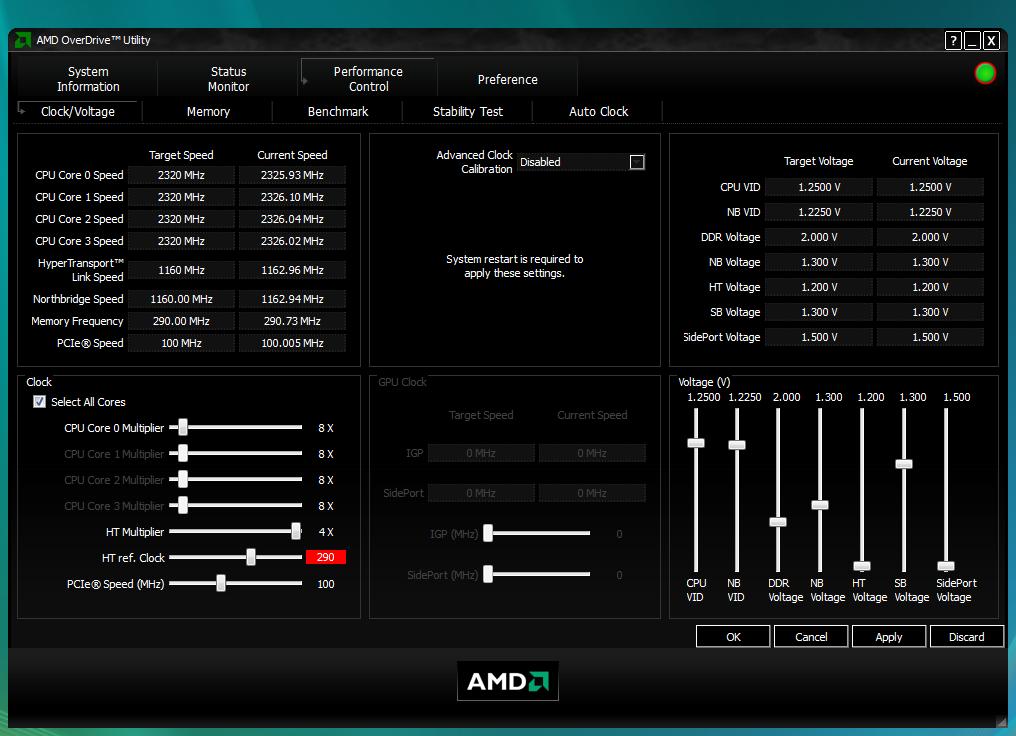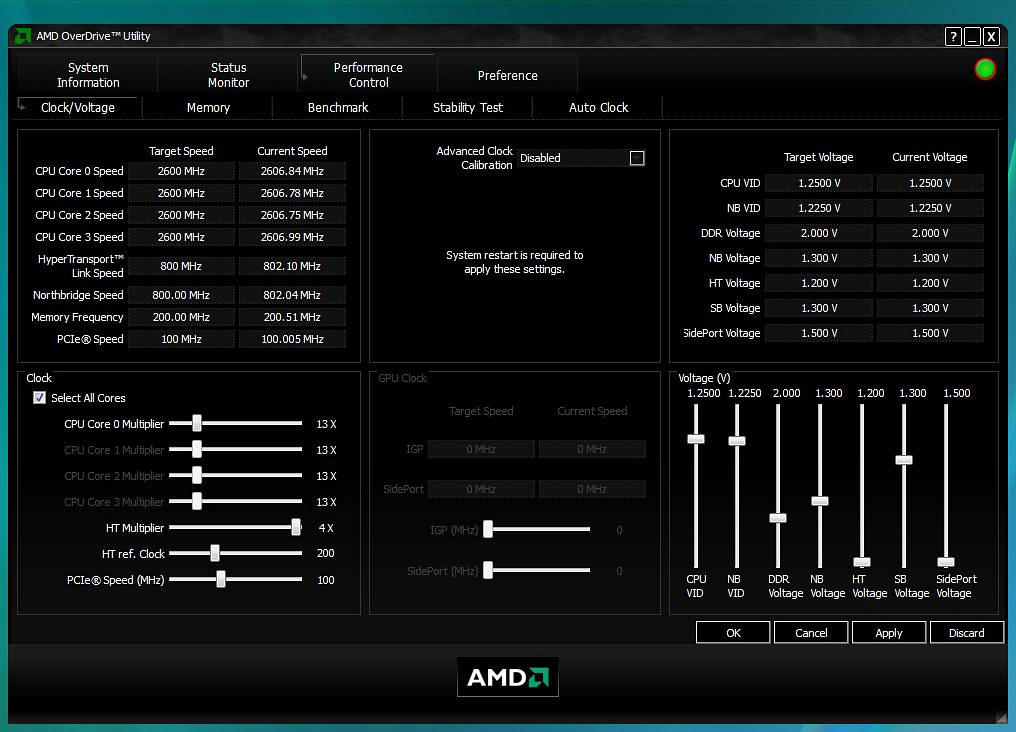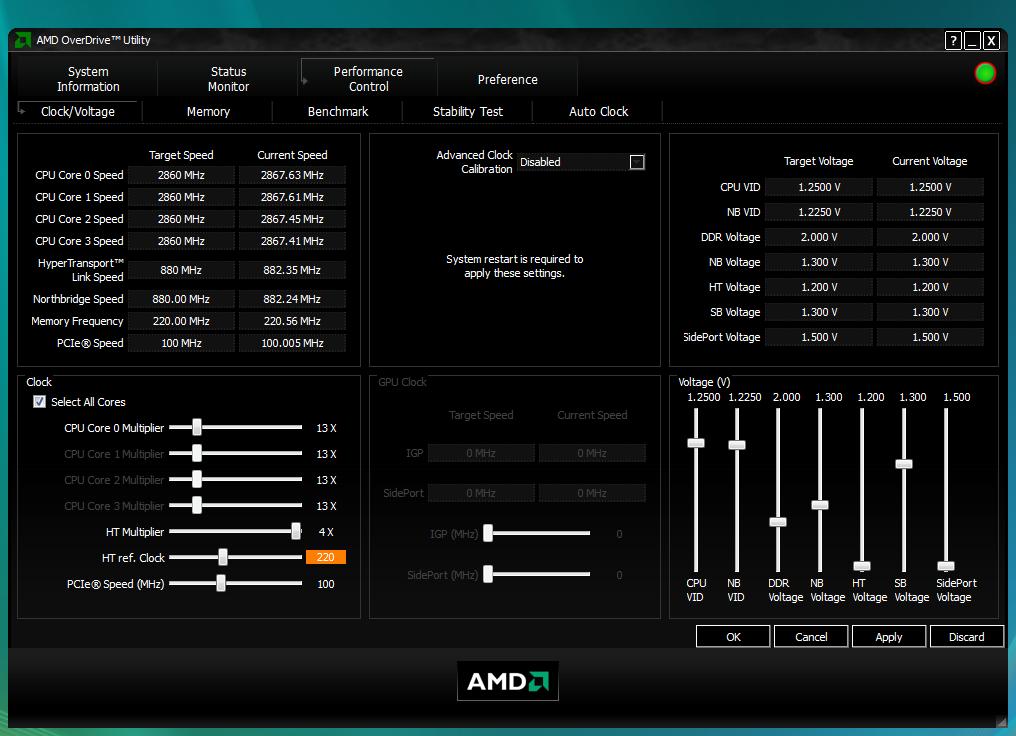How To: Overclocking Your AMD Processor
Advanced Overclocking
The term "advanced" is being used loosely here, in contrast to the easier methods covered thus far, as a way to cover any overclocking through the BIOS and cranking up the reference clock. The success of your overclock will constitute the sum of how well all your components can be pushed, and to find the limit of each, we will take things one step at a time. It is not mandatory to follow all these steps, but finding the maximum for each of your components can help achieve a higher overclock altogether, as well as helping you understand why a limit is reached.
As mentioned, some overclockers prefer to strictly stick to BIOS-based tweaking, while others will find that AOD remains a valuable time-saving tool for testing, without the need to constantly reboot. These settings can then be manually set and further tweaked in the BIOS as needed. Which method you choose is a matter of preference as both have their advantages and disadvantages.
Again, it’s a good idea to disable the Cool’n’Quiet and C1E power-saving features, spread spectrum, and any automatic CPU fan control that keeps the fan from running at a 100% duty cycle. We also had CPU Tweak and Virtualization turned off for part of the tests, but didn’t see an impact either way with our processors. Later on, these features could be activated again as needed and you could then see if there is any impact on system performance or the stability of your overclock.
Finding Maximum Bus Speed
We now move on to the techniques that owners of non-Black Edition chips will need to follow in order to overclock (without the ability to increase the multiplier). Our first step is to find the maximum bus speed (reference clock) that our motherboard and CPU are capable of accomodating. One thing you will quickly notice is the variations in naming of some of our frequencies and multipliers that we previously mentioned. For instance, the reference clock in AOD is referred to as the "Bus Speed in CPU-Z" and "FSB Frequency" in this BIOS:
If you are going to do all of your overclocking in the BIOS, then you will want to reduce the CPU multiplier, the northbridge multiplier, the HyperTransport multiplier, and the memory frequency. In our BIOS, lowering the northbridge multiplier automatically limits the available HyperTransport link frequencies to those at or below the same resulting northbridge frequency. The CPU multiplier can be left alone and instead lowered in AOD, adding the ability to later raise CPU core speed without rebooting.
With our Phenom X4 9950, we selected a CPU multiplier of 8x from within AOD, knowing that even with a 300 MHz bus speed we would still be under the processor's stock core speed. From there, we raised the bus speed from its default to 220 MHz, and then in increments of 10 MHz all the way to 260 MHz. Going beyond 260 MHz, we took it 5 MHz at a time, reaching a maximum of 290 MHz. It is not necessary to take it all the way until instability is found, and we could have easily quit at 275 MHz knowing it would be highly unlikely that we would be running at this high of an northbridge clock speed. Since we overclocked the reference clock from within AOD, we ran the AOD stability test for a few minutes with each increase to be sure it was stable. If doing this from the BIOS, just the ability to boot into Windows is probably a good enough test, in combination with some final stability testing at the higher bus speeds to be sure they are stable.
Get Tom's Hardware's best news and in-depth reviews, straight to your inbox.
Finding Maximum CPU speed
Since we already multiplier-overclocked in AOD, we know the maximum CPU multiplier and also now know the maximum bus speed we can use. With a Black Edition processor, we can experiment with any combination within these limits that allows us to maximize our other frequencies, such as northbridge speed, HyperTransport link speed, and memory frequency. Right now we will continue on as if the multiplier was locked at 13x, as we find the maximum CPU speed by raising the bus speed in increments of up to 5 MHz at a time.
Whether in the BIOS or in AOD, we bring the bus speed back to 200 MHz, and set the multiplier back to 13x, resulting in our stock 2,600 MHz. Note that the northbridge multiplier is still 4, resulting in an 800 MHz speed, while the HyperTransport link speed is also still 800 MHz and the memory is still running at 200 MHz (DDR2-400). We follow the same procedure of increasing the bus speed in increments and by stability testing and making small increases in CPU VID as needed as we finally reach our maximum CPU speed after enabling ACC.
Current page: Advanced Overclocking
Prev Page BIOS Options Next Page Maximizing Performance And Conclusion-
xx12amanxx It's nice to see articles about AMD cpu's once again! Just goes to show that Tom's is not biased but rather report's on current trend's and competetive product's that the consumer's enjoy!Reply
-
Thanks for rev!Reply
Things i like to add are that not all CPU's are supported with AOD even having decent mobo, for example my 4850e + 780G. When overclocking NorthBrige you should really pay attention on it's temp, by simply touching it. Recently i overclocked my system by rising FSB and IGP. Looking at temps given by BIOS and some utilities everything seemed to be ok about 50c, but when touching pasivly cooled NB i couldn't hold my finger for second and heat was so great that even CPU got warmer! When i measured it with multimeter it was 85c idle! And i was wondering why on 3DMark i got blue screen... Problem was solved by adding fan in zone of NB.
Anyway, moral for those who are willing to overclock is - don't relay on temp measurements given by some utilities. Sometimes it's worth double checking or u can burn something easy. :) Good luck! -
jhanschu I realize that the price difference between the "black edition" and normal processors aren't that much, but I have been wondering how well the "vanilla" cpu's would oc. I've done some light searching for anyplace that's done this and haven't found anything other than people attempting to max out the BE's.Reply
Does anyone know what a good OC on say the X3 710 would be? It's about $40 cheaper than the 720BE and if it could even hit close to 3.0 I would consider it a decent buy. -
DjEaZy ... nice one... and for tha fun of it... would be nice to see a 'system build marathon' based on AMD CPU's...Reply -
roofus xx12amanxxIt's nice to see articles about AMD cpu's once again! Just goes to show that Tom's is not biased but rather report's on current trend's and competetive product's that the consumer's enjoy!Reply
I do agree. I honestly don't think TH ever conducted a boycott of AMD. They just needed something worth saying and AMD finally gave them that. Until Phenom 2, they really had not earned recognition for a good year and a half. They didn't have bad products, but very forgettable ones. -
iamlouie It seems like this article was written specifically for me. I recently built a new PC and it has components used in this article and I've also never overclocked a PC before.Reply
Specs:
ASUS M3A78-T
AMD Athlon 64 X2 7750 Kuma 2.7GHz
Patriot Extreme Performance SDRAM DDR2 800 (PC2 6400)
GeForce 7600GT 256MB
XIGMATEK HDT-S1283
Antec 500w Earthwatts power supply
My video card suits my current needs but if I upgrade to a 4870/4850, will I have any power issues if I follow this guide word for word considering my power supply is only 500w compared to the 650w the article uses?
-
iamlouieIt seems like this article was written specifically for me. I recently built a new PC and it has components used in this article and I've also never overclocked a PC before.Specs:ASUS M3A78-TAMD Athlon 64 X2 7750 Kuma 2.7GHzPatriot Extreme Performance SDRAM DDR2 800 (PC2 6400)GeForce 7600GT 256MBXIGMATEK HDT-S1283 Antec 500w Earthwatts power supplyMy video card suits my current needs but if I upgrade to a 4870/4850, will I have any power issues if I follow this guide word for word considering my power supply is only 500w compared to the 650w the article uses?Reply
A single 4850 and a dual core cpu around 3Ghz will be fine on your 500W PSU. If you had a cheap brand 500W PSU, I wouldn't risk it, but a 4850 should be fine for you.
The 4870 probably would be fine too but you would want to look into that before purchasing/installing the card.








